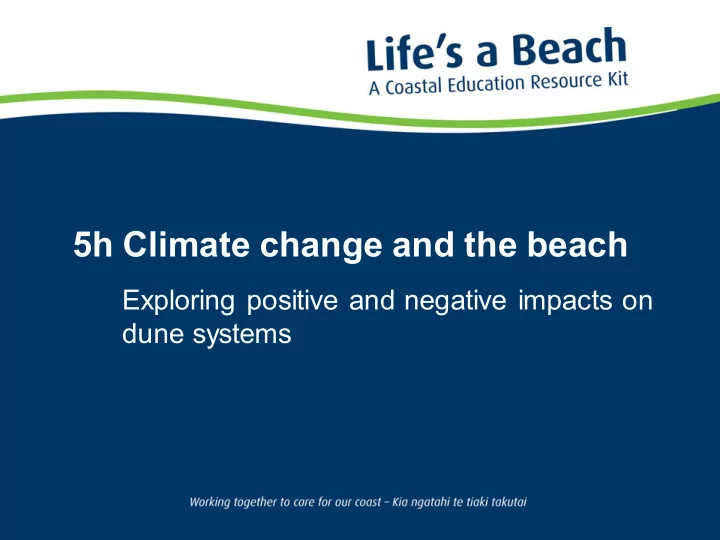

5h Climate change and the beach Exploring positive and negative impacts on dune systems
Coastal hazards • New Zealanders love to live and holiday by the sea which has resulted in extensive coastal development and subdivision. • There are a number of coastal hazards that pose a threat to coastal living. • These include: – Climate change (including associated increase in intensive storms and sea level rise). – Tsunamis. 2
Objectives for today • Today we will look at climate change. – What does climate change have to do with the beach? 3
What does climate change have to do with the sand dunes and the beach? • Climate change is likely to result in increasingly intense storms and sea level rise. • Dunes can buffer us from some storm induced erosion. 4
Sea level rise • Sea level has risen by 10-15 cm over the last century. • Projections are for sea level rises to continue. • By 2050 sea level is projected to have risen 20 cm and up to 50 cm by 2100 (MfE, 2004). • Sea level rise has the potential to be a major problem for coastal communities. 5
Climate change and coastal erosion • Climate change means there is likely to be more coastal erosion. • Even beaches that have been stable and had little erosion may suffer from erosion problems. – Coastal properties and infrastructure could be damaged. 6
Typical immediate Importance of post-storm scarp face – spinifex still active natural dunes • Dune recovery between storms is necessary to prevent further dune retreat. • Dunes with natural Typical post-storm spinifex function can self- response repair after storm cut events – with the native sand binders spinifex and pīngao playing a role in this process. 7
Importance of native dune plants The main native sand binding plants P ī ngao Desmoschoenus spiralis – Threatened K ō whangatara - spinifex Spinifex sericeus – Very abundant The three main native front dune species. All these plants exhibit a useful and unique high tolerance of salt-water, enabling them to rapidly colonise sand returning to the beach after storms. Hinarepe - sand tussock Austrofestuca Littoralis – Threatened 8
The natural storm cut and beach recovery processes (Images from Environment Waikato 2001) • Post storm profile recovery is aided by sandbinding plants colonising the dune scarp, trapping wind-blown sand to repair the dune. 9
Importance of natural dunes Sand being trapped by spinifex (clip from “Life's a Beach” video) • Native dune grasses have a sparse yet rapid growth habit. • Their open habit slows and filters wind, so sand drops out of the wind stream and accumulates around these highly adapted plants i.e. the sand accretes. See PPT 4b formation and function • The low open habit of native sand binders builds smooth, gently sloping aerodynamic dunes. 10
• The accretion function of native front dune plants is significant. • Strong winds preceding rain and storm waves provide fresh accumulations of aerated sand. 11
Importance of natural dunes The storm energy absorption function which results from a mix of: natural dune slope + aerated wind-deposited sand + natural vegetation. June 1997 Degraded dune self-repair ability was a problem for decades. In 1978 the Bay of Plenty Catchment Commission advised residents there were no simple or cheap answers to address their dune instability concerns at Papamoa East. 12
Importance of natural dunes The storm energy absorption function which results from a mix of: natural dune slope + aerated wind-deposited sand + natural vegetation. March 2004 Planting native sand binding species has restored a wide protective dune, which now rebuilds effectively after periodic storm damage. This photo was taken the day after the impact of 10 m waves from Cyclone Ivy. On this occasion wave run-up was dissipated naturally by this now resilient dune. Note: It is possible that climate change will shift the dunes further inland in response to sea level rise and increased storm intensity. Plants alone will not stop this process. 13
Importance of natural dunes Yala Safari Beach Resort, Sri Lanka. Photo courtesy of Dr James Goff, NIWA. The storm/tsunami protection function of natural dunes is a critical consideration. The dune seaward of the resort (background) was bulldozed to improve ocean views. The resort was destroyed on Boxing Day 2004 with the loss of 150 lives. In contrast, the foreground dune with tsunami deposited dinghy was NOT overtopped. 14
The key steps to successful restoration of functional dunes • Establish a dune restoration community/agencies partnership programme. • Remove any obvious threat to successful establishment of native dune plants. • Ensure that sufficient space exists for a restored dune buffer. 15
16
17
The key steps to successful restoration of functional dunes North End Waihī Beach Indicates storm surge run-up (1972) before the dune was restored. 18
19
20
“ A well -shaped and plant-fixed foredune is a land-form of the greatest importance, since it… forms a natural protection against the inroads of the sea, thus safeguarding the coast” Valediction – Dr. L. Cockayne – 1911 21
Helpful reports • The Climate Change Office report “ Community-based Dune Management for the Mitigation of Coastal Hazards and Climate Change Effects: A Guide for Local Authorities ” April 2005 for more detail of dune restoration techniques. • “ Coast Care Programme Independent Review ”, July 2008, Boffa Miskell Ltd for Bay of Plenty Regional Council • “ From Disaster to Restoration: The Power of People ”, prepared for the Environmental Defence Society conference 2004. • Environment Waikato, 2001: Fragile – A guide to Waikato Dunes. Published by Environment Waikato, June 2001, 33p • Coastal Dune Vegetation Network (CDVN) T echnical Bulletins Nos 1-4 on: Pīngao; Spinifex; Sand Tussock; Dune Form and Function. 22
23
Recommend
More recommend